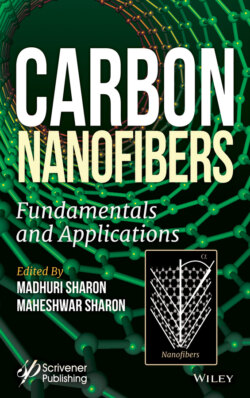Читать книгу Carbon Nanofibers - Группа авторов - Страница 45
2.2.1.2 Characterization of CNF Obtained by Pyrolysis of Plant Seeds
ОглавлениеSEM Images: Morphological characterization of various plant materials (Figure 2.5) by many scientists have shown that CNFs derived from plants have channel-like structure, offering many sites for its use in adsorption/ absorption of organic and inorganic materials, gases and liquids.
XRD Characterizations: Characteristic planes for each carbon material obtained by XRD analysis of carbon materials prepared by the pyrolysis of various precursors are shown in Figures 2.5, 2.6 and 2.7. For comparison, XRD of pure CNF [21] is shown in Figure 2.6. XRD analysis suggests that CNF shows peaks at 26.4°, 42° and 62° for (002), (100) and (103) planes respectively. In addition, XRD spectrum exhibits few broad peaks with weak intensity, indicating low crystallinity of the CNF. The most intense peaks appear close to (002), (100) and (103) peaks for graphitized samples. CNFs can be assumed to be composed of a short-range order of graphitic structure, i.e., partially graphitized carbon. The broadened (100) and (103) peaks also reflect the disordered character of graphite sheets for the CNFs. Carbon obtained from fibrous plant materials shows the development of (002) plane with the exception of carbon obtained from bamboo, which shows very crystalline character (Figure 2.5).
Micro-Raman Characterization: Raman spectrum was taken over a broad frequency range using Elaser = 785 nm = 1.58 eV excitation. Each of the materials showed the presence of D-band and G-band. Their peak positions were not at the same position as one would get from pure graphite and diamond. Ratios of the intensity of G-band and D-band were calculated from each graph obtained from each carbon material. Details of the Raman spectra and the position of D-band and G-band are shown in Figure 2.5.
Figure 2.5 Characterization of CNF obtained by pyrolysis of plant stems (Courtesy of Sunil Bhardwaj).
Figure 2.6 XRD of CNF showing (002) plane of graphite (Hsieh et al., 2003).
For comparison, Raman spectra of amorphous carbon, diamond, graphite and CNT are shown in Figure 2.7. The Raman peaks at 1580 cm-1 in both samples (i.e., CNT and graphite) are attributed to the tangential stretching G mode. The peak at 1400 cm-1 is attributed to disorder-induced D mode which did not occur in the Raman spectrum of the graphite stock. The appearance of D band is due to the defect on the CNTs or the amorphous carbon in the product, which shows the graphitization degree of the product.
The characterizations justified the use of plant material as a unique source of graphitic carbon that can have many applications.
It can be concluded that the CNF synthesized by pyrolysis from fibers of Corn straw (Zea mays), Rice straw (Oryza sativa), Jute straw (Corchorus capsularis), Bamboo (Bombax bambusa), Bagasse (Saccharum officinarum), Cotton (Bombax malabaricum), and Coconut (Cocos nucif- era) exhibit micro-sized channels like morphology of fibers with nanosize pores. Moreover, such CNFs show a lot of similarity with the original anatomy of the plant fibers used as precursor. Carbon waxy contents like tyloses and pits present on fiber tracheids that were seen in the inherent anatomy disappear after pyrolysis and only the carbon skeleton remained [5]. XRD spectra of all the CNFs shown in Figure 2.5 show development of a (002) plane, except CNF obtained from bamboo (which shows crystalline character). Raman studies of all carbon materials showed the presence of G- and D-bands of almost equal intensities, suggesting the presence of graphitic carbon as well as a disordered graphitic structure.
Figure 2.7 (a) Raman spectra of amorphous carbon film showing an overlapping with a broad G-band and D-band [22, 23]. (b) Diamond showing a sharp D-band [24] and (c) showing intense G-band and small hump of D-band obtained for CNT and intense peak of G-band for HOPG [25].
When seeds were pyrolyzed to get CNF, the fibrous tissues present in various seeds yield channel-like fibrous structures which show graphitic nature (Figure 2.8).
